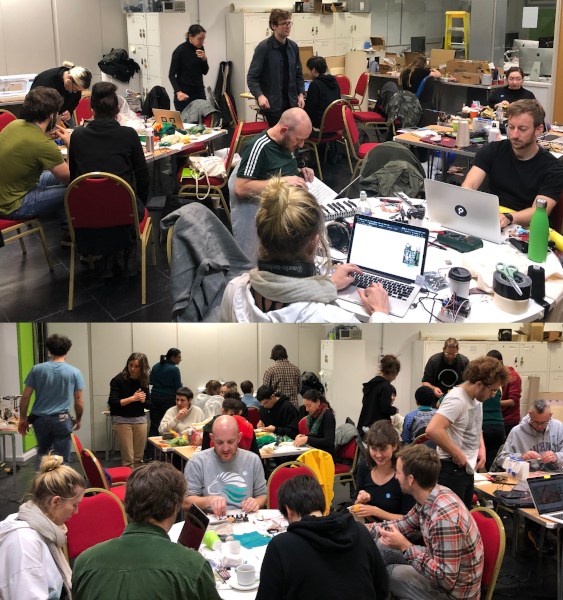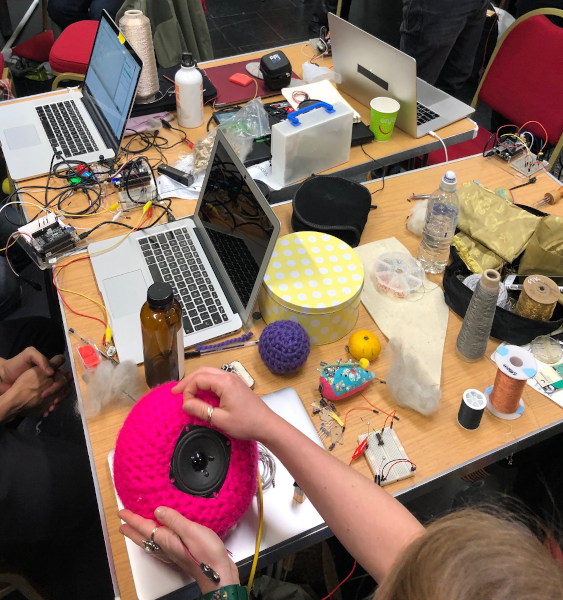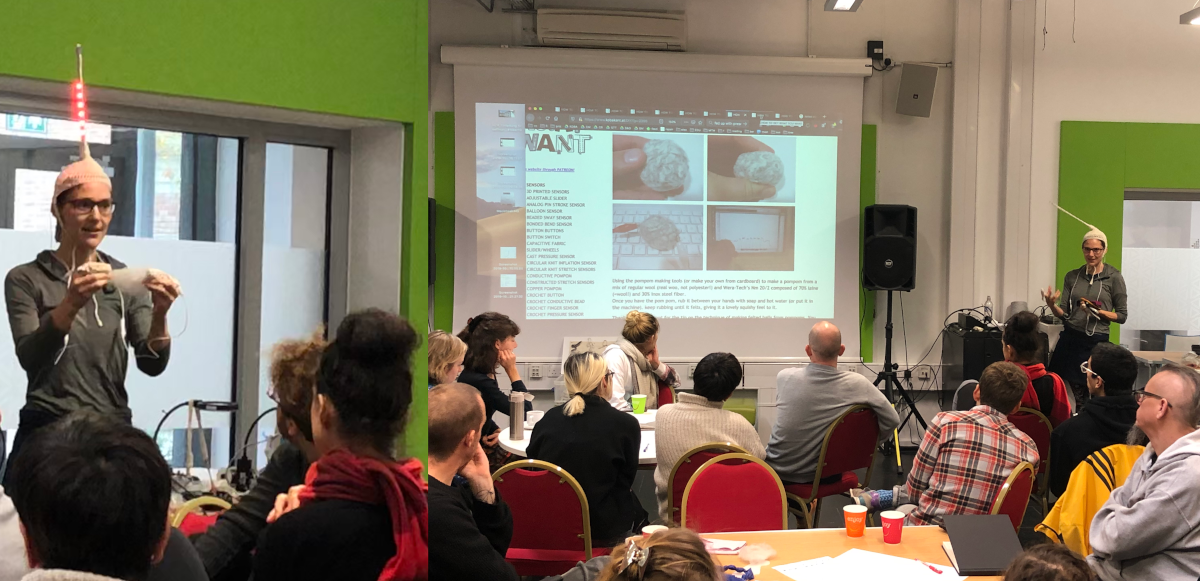Making absurd musical interfaces
Artists, technologists and makers took part in a hackathon around the themes of absurd musical interfaces, questionable sonic interactions and unworkable music designs.
See the Absurd Music Hackathon call for participation


A special thank goes to the wonderful team that, in one way or another, made this event possible: Jonathan Winfield, Angela McArthur, Sophie Skach, Charlotte Nordmoen, Andrea Guidi, Jacob Harrison, Robert Jack, Andrew McPherson, Antonella Nonnis, Lia Mice and Nick Bryan-Kinns.
The Hackathon was supported by the Media and Arts Technology (MAT) doctoral training centre as part of Inter/sections 2019.
Featured Mentors
Hannah and John supported the hackthon in a sublime fashion. These mentors have both significant experience in the fields of music technology, craft, research through design and DIY. They were on site for the all duration of the event, guiding and challenging participants from both technical and theoretical viewpoints.


Useless (but not worthless) music designs
Juan Martinez Avila
A seriously silly guitar strap: augmenting guitar using e-textile technique. A stretchable strap controlling the sound produced by the instrument. Subverting the ways we think about instruments and their attachments. When absurdity reveals the future of music technology.
Lia Mice & Tijs Ham
It’s time to magnify standard music controllers. How music production and performance would change if we use 1.5 meter long slider and knobs with 1 meter of radius? The latest frontiers in high definition technology, ridiculously giant controllers and unpredictable sonic engines.
Andrea Urist
Andrea worked out a beautiful overly complicated sonic machine: grab this stuffed fluffy thing to get a sound back! Repurposing a vintage toy crane motor in a silly sonic experience. This unuseless design plays with arcade games esthetic and expectations: here it is almost impossible not to win!
Maria Svahn, Josefine Holling & Annie Tadne
Introducing the Bug Orchestra. A fully equipped facility to elicit animals’ musical creativity (including red carpet, dance floor and rave area). An artistic residency in which a small ensemble of robotic bugs compose and and perform new music out of quite unpredictable endeavors.
Simon Duck
How to design a keyboard that minimises performance anxiety? Simon came out with the MIDI uncontroller idea: a MIDI keyboard that decide everything for you. Exploiting randomness for almost all the keyboard parameters, the machine takes control away from the musician that can finally stop to care about stressful questions such as “what to play next?” or “how to play this?”.
Antonella Nonnis & Mei Zhang
The Patroniser is a wearable interface exploring troublesonic interactions. The goal is to put in an uncomfortable situation the performers that have to interact with the artefact. The e-textile design is made of a scrubbable and squeezable bra and a hat that can be played by patting on it.
Andrew McPherson & Jacob Harrison
Everyone Can Make Music condenses in one instrument all the most advanced music tech innovations that will ultimately democratise music practice. Finally now everyone can play music! It’s easy, friendly and intuitive. Thanks to this instrument you will make outstanding music in five different styles!
Alice Haynes
A sonic interface inspired by Narwhal whales. If you were in the depth of the ocean, where there is no light and no vision, how you might explore your surroundings? How to communicate with friends and neighbors? A glimpse of sonic uselessness might help you underwater..
Pete Bennett
Pete produced a great number of useless things. These includes an advanced AI technology converting the sound of a kazoo into text. To be more appealing for the market the “banana feature” was introduced. As side projects, Pete also developed a disguise shaker, a Ten oh Ten synth, a pool noodles dance generator and an absurd instrument ideas generator <– please try it! Ah.. Through a successful collaboration with Alice, Pete also focused on an ambisonic chamber based on pool noodle technology. Have a look to Pete’s website to discover all the absurdities he managed to explore during the hacathon!.
Sam Topley
An instrument made of pompoms or knitted balls.. To be positioned in awkward places and played through non-conventional gestures - for example, forward rolling, head butting. A full body flailing experience.
Yusuf Ghani
An instrument that only works against gravity. This means that the musician will only be able to listen to what s/he is doing when both feet go above the ground level. As time flows, the invisible interface travels around the performance space, and eventually, it becomes almost unreachable.
Dominique Baron-Bonarjee
Questioning body movements, dance, meditation and relaxation as non-productive activities. How does “non-doing” sound like? Dominique is interested in exploring the idea of “non-expressing” while making art. Dancing with jelly might be a good starting point.
Sasha de Koninck
Sasha’s ongoing project on seventeenth century embellishment textile techniques. An artistic research that will culminates with a final act in which e-textiles connected to audio circuits are disassembled after many hours of labour. A musical interface that vanishes while the performance takes place.
Marco Martinez
As simple as a machine that creates silence. Actually, this interface is designed to play a very loud silences. You only need: (i) noise cancelling ears plugs and headphones, (ii) a e-textile pressure sensor and (iii) a low pass over some awfully distorted noise.
Giorgia Petri & Laura Migliano
Giorgia and Laura engaged with some pretty cool e-textile materials exploration. Inspired by the art of Origami they assembled a wearable sensors to control sound synthesis. The interface will detect joints such as wrist and elbow articulations. A possible outcome might an interactive musical system in which, like puppets and marionettes, the performer can be moved / played by someone else.
Antonio Nicoletti, Kevin Patton, Lorenzo Minneci & Yusuf Ghani
The Waternet is based on a stretch sensor matrix. A proper collaborative bubbling experience.
Rafaele Andrade
During the Hackathon Rafaele focused on her re-programmable electroacoustic cello: a long run project combining instrument design, live coding, music performance and composition. This was bananas.
John Bowers
After introducing some of his works (e.g. the Ohm My God synth) John supported the attendees with many suggestions and reflections throughout the overall Hackathon. Besides mentoring, John also found the time develop his own absurd musical interface: he tried very hard to screw up a MIDI controller. We believe he succeeded.
Videos and images credits:
- Pete Bennett
- Andrew McPherson
- Alessia Milo
- Antonella Nonnis
- Bruce Gray - Jimi’s Nightmare - Distorted Electric Guitar Sculpture
Inter/sections is supported by:

